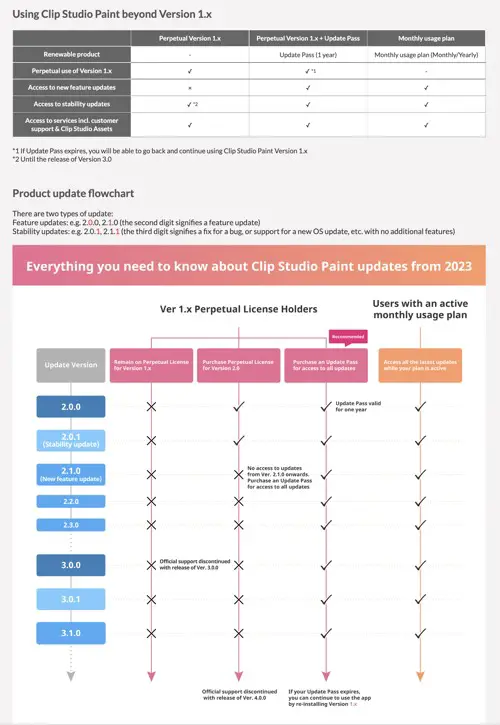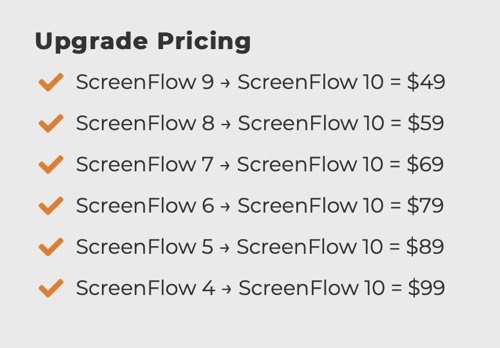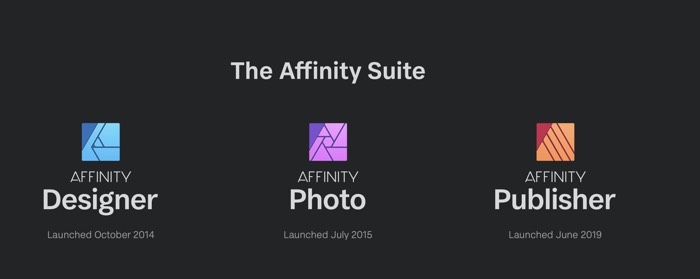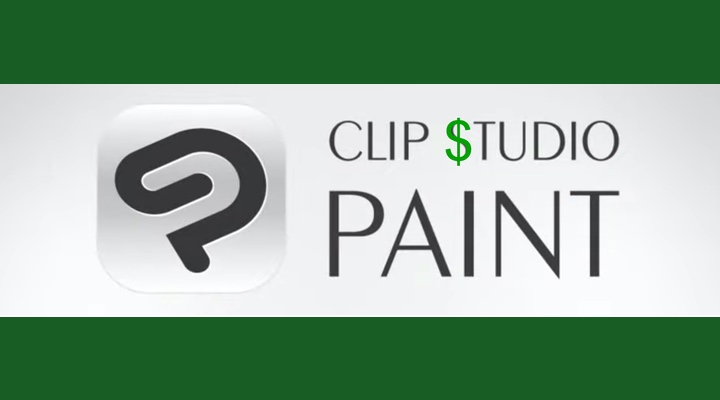Clip Studio Paint Tries Too Hard to Avoid the Word “Subscription” While Requiring a Subscription
Now that the dust has settled and we can see through clearer eyes, let’s talk about the new way Clip Studio Paint will be sold as of 2023.
It Was Inevitable
It was never practical to expect the makers of Clip Studio Paint to provide free updates forever. They couldn’t possible afford to continue developing and improving the software without money coming in.
As a business model, the “one-time purchase/free upgrades forever” model works while the software is in a high growth stage and new people are streaming in. But once those numbers stop accelerating and incoming revenue starts shrinking, the money to pay the developers dwindles and the company can no longer afford to continue.
At the very least, you need to pay for major updates. When a new version is published, that’s the time to pay again. You get a whole new set of features and the software publisher is rewarded for their efforts to maintain and improve the software you are using. Win/win.
The fact that there hasn’t been a single major update with a required payment since Day One of CSP is insane. It’s super generous.
It was fun while it lasted, but you can’t expect it to have lasted forever.
And, yes, I’ve read lots of the comments. The cries of “But we’re starving artists” fall on deaf ears to the people who work on the program and want to feed their families, too. CSP is not something you are entitled to for the rest of your life because you paid for it once.
Where Things Start to Go Astray
Traditionally, these purchasing events were done by charging for updates at significant new versions. For existing users, it would cost maybe half or two-thirds of the original price of the software and include all of the latest updates. In the internet age, it would also include all security bug fixes and many OS update fixes. New users would be buying the software at full price as their way into the platform.
In the smartphone age (mostly due to the iOS App Store), it became subscriptions. Pay a little every month to use the software. Stop paying and the software goes away.
The idea of waiting for major updates to get new features — or creating new releases based on new features — is eliminated with subscription plans. The publisher can publish new features at any time because the subscription is pay-as-you-go. They don’t need to hold back on features for the sake of bundling them up into one arbitrary “major release” where the marketing team can tell a story to justify it.
Subscriptions work well when development is active and features are regularly released. They work when they’re cheap enough that you’re basically paying the same for the software as you would have in the Major Versions release days.
But it doesn’t work in all cases.
That’s where we are today. Everything is a subscription, and it’s maddening. People, myself included, hate subscriptions. We seek out alternatives. I had hundreds of thousands of photographs in Adobe Photoshop Lightroom, but I dropped it as soon as they switched from annual updates to monthly subscriptions. I always bought every other edition of Lightroom. I didn’t need the incremental updates, but I wanted to get the new features as they added up, and I did want to show Adobe that I valued their software enough to pay for it once every couple of years. And, honestly, I resented that Adobe felt that they had locked me into their software so they could start charging me more.
The people behind Clip Studio Paint aren’t dumb. They know that their users hate subscriptions. While it was necessary to have them to survive in the mobile space of iPads and phones, it wasn’t needed in the world of desktop applications. The higher price covered a lot of costs.
Read the initial press release on this pricing change and one thing will jump out at you — they spin and they spin to avoid the word “subscribe.” No form of that word is used even once in their initial release. You’re not subscribing to their software; you’re buying annual or monthly passes.
Slick, but we see right through it.
Crazy Subscription Avoidance – Where Things Went Wrong
They tried too hard to avoid the word “subscription” and completely screwed the pooch. They made a convoluted plan — Update Pass! Monthly Plan! Perpetual Licenses! WTF?!? — that confused 90% of people who were railing on them on Twitter.
They looked like they were hiding something. They overlooked the simplest solution to the problem in the name of being everyone’s favorite kind of software company these days, a SAAS (Software As A Service.)
I would like to explain to you how it all works, but all of my attempts ended with me curled up into the fetal position underneath my desk in tears.
It’s such a messed up system that they had to provide two different charts to help explain it.

When your business model gets this convoluted, it’s time to scratch it and start over again.
Here’s the Plan CSP Should Have Offered
Major Release: Buy version 2 and get all v2.x updates. Security and OS updates for v2 will be offered until v4.x comes out. If possible (i.e. not inside the App Store), offer a reduced price on the next update to the software for people who paid for the current version.
The model for this is Telestream, makers of the ScreenFlow app. They charge a different upgrade price depending on which version of the software you last paid for, going back multiple versions. It’s cheaper to go from v9 to v10 than it is to go from v6 to v10. It’s fair, it’s easy to understand, and it rewards the user for keeping up to date.

Subscription Plan: Here there’s no up front cost. Just pay every month (with a slight discount if you pay a year in advance) and use the latest and greatest version of CSP. Don’t pay and you don’t use it. Stop paying for a month and when you pay for a month next time, you get the most recent version of the software. That’s how it works in iOS with the iPad version of the software in the Monthly Plan.
Simple, right?
Nope, that’s not what CSP is doing here.
Where CSP Lost Me
I’m not going to spend the next thousand words explaining everything the folks behind CSP want you to understand. Every explanation I’ve heard of it is different. It’s remarkable that it’s so complicated and difficult to explain that no two people are able to see the same thing.
But I’ll give you the aspect of the new deal where I lost it:
First, you buy a Perpetual License. That’s the equivalent of buying the Major Release. It’s the full price of the software and a one-time purchase. Use it for as long as you can, and they’ll support it with OS updates and security updates for two generations of the software.
Except — you don’t get the dot releases. If you buy a Perpetual License for v2, you do not get v2.1 or anything afterward. That’s when you have to start subscribing.
That’s super obnoxious.
You know what’s even worse? If you do subscribe with their annual Update Pass (pssst, don’t call it a “subscription”), once you no longer pay the annual fee, you can only use the version from your Perpetual License. You could have been paying for years for the software, but you only get credit for that initial Perpetual License.
Cadence of Release
The other variable I haven’t accounted for so far is the frequency of updates. This is where CSP can get into some serious trouble with their customers.
CSP has never been a rapidly-updated app. There are still major bits of functionality people have been clamoring for for years. (CMYK support, anyone?)
If CSP is regularly charging its users for a program that doesn’t get updated at a pace where the users feel they’re getting their money’s worth, that’s a problem. If they can’t push a major new release out every 12 – 18 months, the math will fall apart and the app will start to look more and more needlessly expensive. Users will feel like they’re being overcharged.
With all this new money flowing in on a regular basis, the makers of CSP have to speed up their production and justify their new business model.
I think THAT will be the biggest issue in the future. A subscription is a major speed bump, but a subscription without value is a killer.
Is This the End of the Quarterly Sales?
Once the subscription model is in place, will they continue to have the quarterly CSP half-price sales?
The only way that the old model worked was if they continued to bring in more paid users. Those quarterly sales helped to keep those numbers up. From a financial perspective, they also happened at the end of every financial quarter, just when I’m sure they wanted to get their numbers looking their best at the last minute.
But if they want everyone to be an ongoing subscriber, does a sale on perpetual licenses make sense?
I’d argue that it does, just because it lowers the bar to bringing people in. If users want to have that backstop in case they stop subscribing, then they’ll need a perpetual license at every major release.
This also helps current subscribers who want to keep their backstop up to date with the most recent major release.
But, again, everything about this plan is so complicated and convoluted that I may have missed something.
Run the Numbers
There’s a chance that this isn’t the end of the world. It might just be needlessly confusing and a nightmare for CSP’s customer support staff.
Obviously, if you believe in unicorns and think that all software should be a one-time purchase for life, you’re never going to be happy and you might as well ignore the rest of this essay.
CSP has said that the Update Pass will cost “a lower price than Monthly Usage Plans” while the perpetual licenses will have no change. Those Monthly Usage Plans (for the PRO version that I use) are $4.49 a month, or $24.99 if bought a year at a time.
If the Update Pass turns out to be $20 a year, that’s not a terrible price to pay for all the updates that come with it. I’d happily pay that. For a piece of software that I use constantly and rely on for my work/hobby/blog side project, that’s acceptible. Heck, it’s minimal.
If updates are slow or don’t add a whole lot, then it might be worth just buying a perpetual license with every other major release.
If it helps you, though, you can also re-orient your thinking this way and buy every Major Release: Chalk it up to paying for a new update that contains all the dot releases of the previous version along with this first (.0) version of the new release.
For example: When you buy v3, you’re really paying for v2.1 – v3.0. The semantic version numbering is fairly arbitrary and mostly used as a marketing tool anyway. Skip the subscri– er, “Update Pass.” If the updates between major releases aren’t that significant to the way you use CSP, skip it and wait for the next one.
If you’re a working professional who uses CSP in your day-to-day job, then the Update Plan will be the plan for you. It’s the cost of doing business and it’s not that high a cost anyway.
Ultimately, we’ll need to see what they announce as their prices for all these new levels of “ownership.” (“User-ship”, maybe?) Yes, you’ll wind up paying more than nothing, but it’s not an outrageous price.
This isn’t the $600 per version that Photoshop used to charge before Adobe went subscription. Now it “only” costs a minimum of $120 a year on a subscription, which is still much larger than CSP says they plan to charge.
What’s the software worth to you? Do you enjoy using it? Does it do what you need it to do? Do you want to see it continue? Is $25 a year really the breaking point for you? $50?
Let’s see what numbers CSP comes up with.
In the end, I don’t think it’s a bad thing to charge for major new releases of software. I think some of the details they’ve come up with here are needlessly complicated and confusing. I think they’re bending over backwards not to say “subscription,” which is exactly what this is.
When the dust settles on this in a couple of years, I don’t think it’ll be a major thing. And I don’t think there’s a competitor worthy of CSP at anywhere near this low a price for what you get.
One Last Thought/Prediction

I love the Affinity trio of apps — Photo, Designer, Publisher — but I fear that they’re on this same path, as well.
How long will they last before they have a paid-for upgrade or have to move to a subscription plan and the internet goes crazy?
Hopefully, they’ve learned the lessons that examples like CSP have shown us on how not to do it.
(For iPad users, I wonder how long Procreate will last, too. It’s price has gone up over the years a little bit, but there’s never been a subscription option or a totally new version to buy that I can remember. WIth all the power that application has and all of its professional uses now, I can’t imagine the $10 one-time charge will last forever.)
